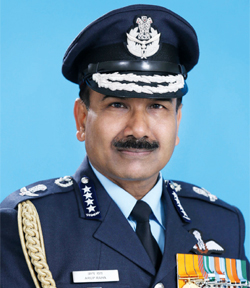 | By Air Marshal B.K. Pandey (Retd)
Former Air Officer Commanding-in-Chief of Training Command, IAF |
As per reports in the media, efforts by the Indian Air Force (IAF) to augment its existing fleet of 75 Pilatus PC-7 Mk II turboprop trainer aircraft through procurement of the second lot of 38 of these platforms from the Swiss aerospace firm Pilatus, appears to have hit a roadblock, leaving the IAF with no choice but to abandon plans in this regard.
TRAINER AIRCRAFT FOR THE IAF
The IAF has been encountering serious difficulties with its trainer fleet for more than a decade. The HT-2 was the first piston-engine trainer aircraft developed by the Indian aerospace major Hindustan Aeronautics Limited (HAL) in the late 1940s. The HT-2 entered service with the IAF in 1953 and remained effective for over four decades. The HPT-32 Deepak, a single piston-engine aircraft was developed by HAL in the late 1970s to replace the fleet of HT-2. Deliveries of the HPT-32 Deepak commenced in 1984. Unfortunately, the HPT-32 fleet was plagued with a number of technical problems that led to as many as 17 crashes in which 19 pilots perished. Following a fatal accident on July 31, 2009 involving and HPT-32, Air Headquarters decided to withdraw the fleet from service prematurely. As HAL was not in a position to provide a replacement for the HPT-32 fleet within a reasonable time frame, the IAF went in for the procurement of the first batch of 75 Pilatus PC-7 Mk II basic turboprop trainer aircraft from Switzerland.
If we are serious to rectify the scam, we should by all means penalise the company and convict the middleman. But we cannot undermine the “utility” of the platform procured with a due process nor the persisting requirements of the concerned force.
The total requirement of basic trainer aircraft for the IAF has been assessed as 181. Even after the move by the IAF for the emergency procurement of 75 Pilatus PC-7 Mk II from Switzerland, the residual number of 106 trainer aircraft required for the IAF was large enough for HAL to embark on a project to develop a turboprop trainer aircraft which was designated as the HTT-40. Although the HTT-40 undertook its maiden flight on May 31, 2016, the time frame for its availability to the IAF continues to remain shrouded in uncertainty. Meanwhile, with the fleet of Kiran jet trainers approaching the end of its total technical life and the availability of the HAL developed Intermediate Jet Trainer not in sight, the IAF adopted a “Two Aircraft, Three-Stage Training” pattern in which the Pilatus is employed for both Stage I and II training. This necessitated the procurement on an urgent basis of an additional 38 Pilatus PC-7 Mk II aircraft for which the IAF initiated a case with the original equipment manufacturer (OEM) Pilatus of Switzerland through the Ministry of Defence (MoD). The first deal for the procurement of 75 Pilatus trainers contained a clause for a follow-on purchase of 38 more planes. However, this new order for 38 aircraft effectively reduced the quota for HAL from 106 to mere 68 basic trainer aircraft for which the development of the HTT-40 was already underway. However, despite the reduction in orders, HAL has continued with the development of the HTT-40.
TROUBLE FOR THE PILATUS DEAL
Unfortunately for the IAF, there is trouble brewing for the proposal to procure an additional 38 Pilatus PC-7 Mk II aircraft from Switzerland. Apparently, the Central Bureau of Investigation (CBI) has come across some evidence of wrong-doing in the deal for 75 Pilatus PC-7 Mk II aircraft. Reports indicate that some arms dealer in India as also officers in the MOD and the IAF are suspected to be involved in influencing the deal. Probe by the CBI into the unauthorised involvement of agencies and individuals in the deal and in the allegations of corruption and irregularities, is currently in progress. As such, the government has conveyed to the IAF that in view of the probe by the CBI in the alleged wrong-doing in the deal, the IAF is not to pursue the follow-on option. The government has further stated that if the IAF needs additional trainer aircraft urgently, it can explore other options in the world market for direct purchase of the required number of aircraft from the selected vendor. Given the complexities of the Defence Procurement Procedure, it will not be easy for the IAF to turn the proposal to procure additional 38 aircraft into reality in a respectable time frame. Besides, as it is unlikely, if not impossible, for the IAF to find 38 Pilatus PC-7 Mk II trainer aircraft outside Switzerland, the IAF will have to look for another similar type with performance and capabilities matching that of the Pilatus PC-7 Mk II. This however, would not be a practical option for the IAF as the number being restricted to 38, would be too small an order and would entail a separate logistics management and maintenance set up for the IAF. Perhaps it would be an easier option for the IAF to wait for the HTT-40 even though it is a distant dream at this point in time.

“We are already working on a three stages, two aircraft training system in our training command. The pilatus PC-7 Mk II Basic trainer is a reasonably good aircraft with a reasonable flight envelop to substitute the training that was planned on the Intermediate jet Trainer. PC-7 is going to take on not only stage 1 for fighter flying and other streams like transport and helicopters but stage 2 on fighter will also be done and is being done as on today on the PC-7. The feedback is extremely encouraging.”
—Air Chief Marshal Arup Raha in September 2015
But the issue which is more relevant and pertinent is the action that the government has been taking so far in the event of a suspected or proven case of wrong-doing that come to light in deals related to procurement of defence equipment. The government invariably resorts to cancellation of the deal, blocking of further procurements and even blacklisting the OEM involved. This has been the practice adopted by the government since the alleged scam in the procurement of artillery guns from Bofors of Sweden in the 1980s. The guns were procured during the tenure of Rajiv Gandhi as the Prime Minister, but the scam was unearthed during Prime Minister VP Singh’s tenure. The Swedish Company was blacklisted and thereafter, the Indian Army was unable to procure artillery guns as part of its modernisation plans for several decades.
IMPLICATIONS FOR NATIONAL SECURITY
There have been a number of alleged irregularities since the Bofors scam, a recent one being the procurement of helicopters for use by VVIPs in which the contract was cancelled after three of the 12 helicopters contracted for, were delivered. The IAF is now left holding the baby! However, despite prolonged investigations in the cases of alleged scams over the last few decades, there has not been a single case where investigations have been successful in reaching finality and taking individuals responsible for wrong-doing, to task.
Who Are the Losers? In all this, it is the Indian armed forces that suffer as this practice impinges seriously on and even neutralises their effort at timely modernisation of their weapon systems, placing them at serious disadvantage visa-vis the adversaries. In the final analysis, the way the governments have been handling cases of suspected or proven scam, ultimately leads to the undermining of national security. The right course of action would be to take to task individuals responsible for wrong-doing, avoid blacklisting of the company and continue with the process of procurement of defence equipment to prevent any compromise to national security. It is important to understand that with the practice followed currently by the government to deal with allegations of scam in procurement of defence equipment, it is the nation that stands to lose. The undebatable fact is that the National Security is the paramount for anybody and everybody belonging to the country.
Who Are the Gainers? Despite prolonged and intensive investigation by the concerned agencies of the government into allegations of scam in deals related to procurement of defence equipment that is meant entirely for the benefit of the nation, the gainer unfortunately, is not the nation, but perhaps only the media that scores brownie points through extensive coverage in the pursuit of TRP. While the government may not care for the Indian armed forces, it is of vital importance that the interests of nation must not be compromised in any way which unfortunately is happening now.
Opportunity to Establish Credibility. Despite the controversy, the Bofors guns proved their worth as an excellent weapon system during the war in Kargil in 1999. The embargo on transactions with Bofors was reviewed and lifted thereafter. But it is important to understand that the selection of a potent weapon systems is carried out through elaborate and competent professional evaluation. An important aspect is that the weapon system selected and acquired is of such repute and credibility that it would serve as an effective deterrent. This is important as the Indian armed forces may not always get the opportunity to prove the capability of a weapon system through a situation of war or military conflict as was the case with the Bofors guns. Questions remain, do we need the crisis to prove and to understand the usability of weapon systems or trainers and alike. Is it really difficult to value the usability and necessity of these platforms without the crisis?










